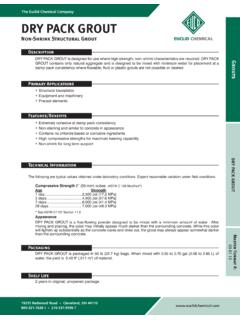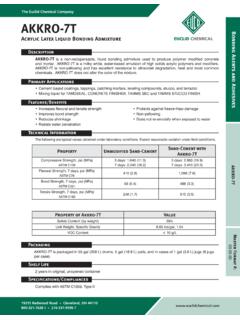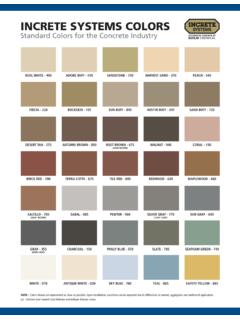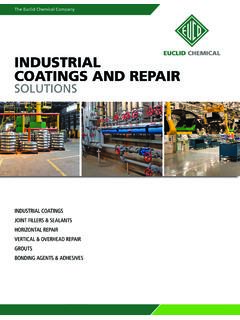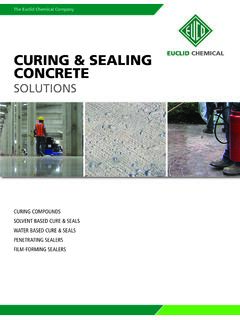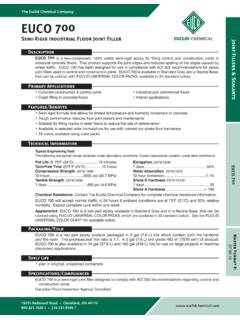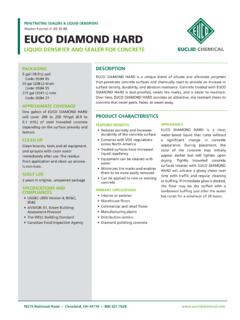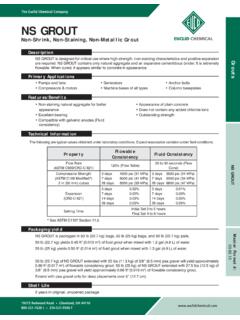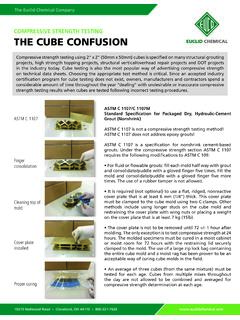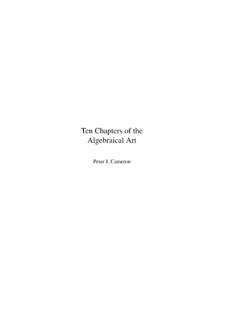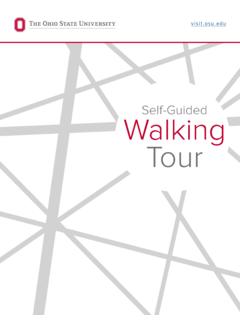Transcription of SAFETY DATA SHEET - Euclid Chemical
1 Version: Revision Date: 02/05/2020 800000050708 1/14 SAFETY data SHEET 1. Identification Material name: EUCOCRETE Material: 065C 50 Recommended use and restriction on use Recommended use: Cement, Portland, chemicals Restrictions on use: Not known. Manufacturer/Importer/Supplier/Distribut or Information Euclid Chemical COMPANY 19218 REDWOOD ROAD CLEVELAND OH 44110 US Contact person: EH&S Department Telephone: 216-531-9222 Emergency telephone number: 1-800-424-9300 (US); 1-613-996-6666 (Canada) 2. Hazard(s) identification Hazard Classification Health HazardsSkin Corrosion/Irritation Category 2 Serious Eye Damage/Eye Irritation Category 1 Skin sensitizer Category 1 Carcinogenicity Category 1A Specific Target Organ Toxicity - Single Exposure Category 31. Specific Target Organ Toxicity - Repeated Exposure Category 12.
2 Target Organs 1. Respiratory tract irritation. 2. Lung Unknown toxicity - Health Acute toxicity, oral % Acute toxicity, dermal % Acute toxicity, inhalation, vapor 100 % Acute toxicity, inhalation, dust or mist % Hazard Symbol: Label Elements Version: Revision Date: 02/05/2020 800000050708 2/14 Signal Word: Danger Hazard Statement: Causes skin irritation. Causes serious eye damage. May cause an allergic skin reaction. May cause cancer. May cause respiratory irritation. Causes damage to organs through prolonged or repeated exposure. Precautionary Statements Prevention: Wash thoroughly after handling. Wear protective gloves/protective clothing/eye protection/face protection. Contaminated work clothing should not be allowed out of the workplace. Obtain special instructions before use. Do not handle until all SAFETY precautions have been read and understood.
3 Use personal protective equipment as required. Use only outdoors or in a well-ventilated area. Do not breathe dust/fume/gas/mist/vapors/spray. Do not eat, drink or smoke when using this product. Response: IF INHALED: Remove person to fresh air and keep comfortable for breathing. IF IN EYES: Rinse cautiously with water for several minutes. Remove contact lenses, if present and easy to do. Continue rinsing. IF ON SKIN: Wash with plenty of water/C If skin irritation or rash occurs: Get medical advice/attention. Immediately call a POISON CENTER/doctor. Specific treatment (see on this label). Wash contaminated clothing before reuse. Storage: Store locked up. Store in a well-ventilated place. Keep container tightly closed. Disposal: Dispose of contents/container to an appropriate treatment and disposal facility in accordance with applicable laws and regulations, and product characteristics at time of disposal.
4 Hazard(s) not otherwise classified (HNOC): None. 3. Composition/information on ingredients Mixtures Chemical Identity CAS number Content in percent (%)* Version: Revision Date: 02/05/2020 800000050708 3/14 Crystalline Silica (Quartz)/ Silica Sand 14808-60-7 50 - <100% Portland cement 65997-15-1 20 - <50% Fumed silica 69012-64-2 - <1% Calcium hydroxide 1305-62-0 - <1% * All concentrations are percent by weight unless ingredient is a gas. Gas concentrations are in percent by volume. 4. First-aid measures Description of necessary first-aid measures Inhalation: Move to fresh air. Skin Contact: Get medical attention. Destroy or thoroughly clean contaminated shoes. Immediately remove contaminated clothing and shoes and wash skin with soap and plenty of water. If skin irritation or an allergic skin reaction develops, get medical attention.
5 Eye contact: Immediately flush with plenty of water for at least 15 minutes. If easy to do, remove contact lenses. Call a physician or poison control center immediately. Ingestion: Call a POISON CENTER/doctor if you feel unwell. Rinse mouth. Personal Protection for First-aid Responders: Self-contained breathing apparatus and full protective clothing must be worn in case of fire. Most important symptoms/effects, acute and delayed Symptoms: Prolonged or repeated contact with skin may cause redness, itching, irritation and eczema/chapping. Extreme irritation of eyes and mucous membranes, including burning and tearing. Respiratory tract irritation. Hazards: No data available. Indication of immediate medical attention and special treatment needed Treatment: Symptoms may be delayed. 5. Fire-fighting measures General Fire Hazards: No unusual fire or explosion hazards noted.
6 Suitable (and unsuitable) extinguishing media Suitable extinguishing media: Use fire-extinguishing media appropriate for surrounding materials. Unsuitable extinguishing media: Do not use water jet as an extinguisher, as this will spread the fire. Specific hazards arising from the Chemical : During fire, gases hazardous to health may be formed. Version: Revision Date: 02/05/2020 800000050708 4/14 Special protective equipment and precautions for firefighters Special fire fighting procedures: No data available. Special protective equipment for fire-fighters: Self-contained breathing apparatus and full protective clothing must be worn in case of fire. 6. Accidental release measures Personal precautions, protective equipment and emergency procedures: See Section 8 of the SDS for Personal Protective Equipment.
7 Do not touch damaged containers or spilled material unless wearing appropriate protective clothing. Keep unauthorized personnel away. Accidental release measures: In the event of a spill or accidental release, notify relevant authorities in accordance with all applicable regulations. Methods and material for containment and cleaning up: Collect spillage in containers, seal securely and deliver for disposal according to local regulations. Environmental Precautions: Do not contaminate water sources or sewer. Prevent further leakage or spillage if safe to do so. 7. Handling and storage Handling Technical measures ( Local and general ventilation): Mechanical ventilation or local exhaust ventilation may be required. Observe good industrial hygiene practices. Observe occupational exposure limits and minimize the risk of inhalation of dust.
8 Safe handling advice: Ventilate well, avoid breathing vapors. Use approved respirator if air contamination is above accepted level. Use mechanical ventilation in case of handling which causes formation of not handle until all SAFETY precautions have been read and understood. Obtain special instructions before use. Use personal protective equipment as required. Do not get in eyes. Wash hands thoroughly after handling. Avoid contact with skin. Avoid contact with eyes, skin, and clothing. Contact avoidance measures: No data available. Hygiene measures: Observe good industrial hygiene practices. Wash hands before breaks and immediately after handling the product. Do not get in eyes. Wash contaminated clothing before reuse. Avoid contact with skin. Contaminated work clothing should not be allowed out of the workplace. Storage Safe storage conditions: Store locked up.
9 Safe packaging materials: No data available. 8. Exposure controls/personal protection Version: Revision Date: 02/05/2020 800000050708 5/14 Control Parameters Occupational Exposure Limits Chemical Identity Type Exposure Limit Values Source Crystalline Silica (Quartz)/ Silica Sand - Respirable fraction. TWA mg/m3 US. ACGIH Threshold Limit Values, as amended (2011) Crystalline Silica (Quartz)/ Silica Sand - Respirable dust. TWA mg/m3 US. OSHA Specifically Regulated Substances (29 CFR ), as amended (03 2016) OSHA_ACT mg/m3 US. OSHA Specifically Regulated Substances (29 CFR ), as amended (03 2016) Crystalline Silica (Quartz)/ Silica Sand - Respirable dust. PEL mg/m3 US. OSHA Table Z-1 Limits for Air Contaminants (29 CFR ), as amended (03 2016) Crystalline Silica (Quartz)/ Silica Sand - Respirable.
10 TWA millions of particles per cubic foot of air US. OSHA Table Z-3 (29 CFR ), as amended (2000) TWA mg/m3 US. OSHA Table Z-3 (29 CFR ), as amended (2000) Portland cement - Respirable fraction. TWA 1 mg/m3 US. ACGIH Threshold Limit Values, as amended (2011) Portland cement - Total dust. PEL 15 mg/m3 US. OSHA Table Z-1 Limits for Air Contaminants (29 CFR ), as amended (02 2006) Portland cement - Respirable fraction. PEL 5 mg/m3 US. OSHA Table Z-1 Limits for Air Contaminants (29 CFR ), as amended (02 2006) Portland cement TWA 50 millions of particles per cubic foot of air US. OSHA Table Z-3 (29 CFR ), as amended (2000) Fumed silica TWA 20 millions of particles per cubic foot of air US. OSHA Table Z-3 (29 CFR ), as amended (2000) TWA mg/m3 US. OSHA Table Z-3 (29 CFR ), as amended (2000) Calcium hydroxide TWA 5 mg/m3 US.
